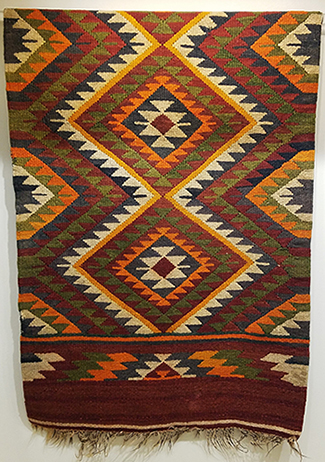Bedouin Rug
 This Bedouin rug was purchased in Amman, the capital city of Jordan, but made in the ancient town of Madaba. The Arabic-speaking Bedouin are a nomadic people who live across the deserts of the Middle East and North Africa. Bedouins in the area of Jordan are traditionally sheep or goat herders, which allowed them to develop a strong weaving tradition using the wool gathered from their own herds. Weavers, conventionally women, make many items suited to a mobile life including rugs, pillows, and other domestic goods. Bedouin geometric patterns, like the ones found in this rug, influenced many other weavers around the world. Bedouin designs are found across North Africa, which influenced the Spanish, which in turn inspired Navajo designs once they arrived in the New World. The rug is currently on display in the Museum in preparation for our July 23 workshop on world textiles.
This Bedouin rug was purchased in Amman, the capital city of Jordan, but made in the ancient town of Madaba. The Arabic-speaking Bedouin are a nomadic people who live across the deserts of the Middle East and North Africa. Bedouins in the area of Jordan are traditionally sheep or goat herders, which allowed them to develop a strong weaving tradition using the wool gathered from their own herds. Weavers, conventionally women, make many items suited to a mobile life including rugs, pillows, and other domestic goods. Bedouin geometric patterns, like the ones found in this rug, influenced many other weavers around the world. Bedouin designs are found across North Africa, which influenced the Spanish, which in turn inspired Navajo designs once they arrived in the New World. The rug is currently on display in the Museum in preparation for our July 23 workshop on world textiles.

